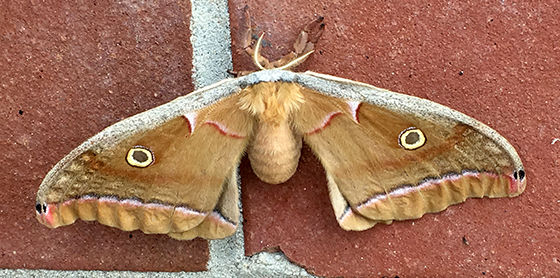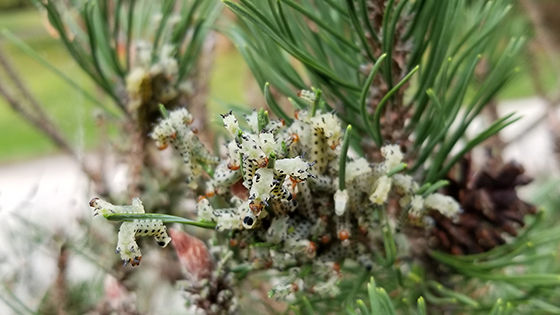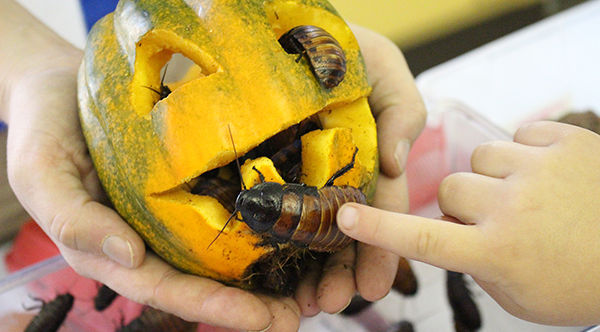There is a definite "otherness" to insects and spiders. When looking at a tarantula, it’s huge and hairy and hard to tell where the face is. They can seem very alien to people and for some that triggers a fear response. With cockroaches, people equate them to dirtiness and trash and decay, but that’s their job — to get rid of decaying material. Insects are essential to our ecosystems. Without them, most ecosystems simply collapse.
A Curious Collection of Creepy Crawlers
Some people are dog people. Others are cat people. Still others have a marvelous menagerie of furry, feathery and scaly friends. Sarah Howard, a Certified Investigator Trainer at Temple University Harrisburg, took a decidedly different path. Her passion is arachnids and insects. Her first eight-legged pet? A rose-haired tarantula (Grammostola porteri) named Doris, who has been joined by more than 80 other friends! Read about Sarah and her collection here.
Teeny Tiny Tarantulas
Not all tarantulas are huge, especially when they’re babies! In this video, Sarah Howard focuses on the smallest tarantulas.
Tarantula Anatomy
What is the anatomy of a tarantula? You’re about to find out! Join Sarah Howard and learn about the parts of a tarantula’s body.
Taxonomy and Names
In this video we learn about how tarantulas are classified in the Animal Kingdom, and about some other animals that have things in common with tarantulas. Sarah Howard also shares the importance of scientific names.
How Tarantulas Grow
Like every other living thing, tarantulas grow up! Join Sarah Howard and learn how tarantulas grow by molting their old exoskeletons.
Aphid Mummies!
Aphid Mummies! Let that wash over you for a bit. It sounds like the title of a 50's sci-fi movie - Attack of the Killer Aphid Mummies! This, however, is science fact and happening right here in the Arboretum. Join Ambler Arboretum Director Kathy Salisbury as she brings you up close to aphid mummies!
Spotted Lanternfly Basics from iEcoLab
According to the Pennsylvania Department of Agriculture, the Spotted Lanternfly is an invasive species native to China, Bangladesh, and Vietnam. In 2014 it was found in Pennsylvania, and has since spread to 26 counties which are now quarantined. If you see a Spotted Lanternfly, it's imperative to immediately report it online or via phone by calling 1-888-4BADFLY. This pest poses a significant threat to the state’s more than $28 million grape, $87 million apple, and more than $19 million peach industries, as well as the hardwood industry in Pennsylvania, which accounts for nearly $17 billion in sales. In this video from Victoria Ramirez, Lab Manager at iEcoLab in Temple’s Department of Biology, learn the basics about the spotted lanternfly and how you can do your part to control them.
Viral Water Bottle Hack for Trapping Spotted Lanternfly
The Pennsylvania Department of Agriculture is not subtle about what you should do if you see a spotted lanternfly — "Kill it! Squash it! Smash it! Just get rid of it!" You get the idea. iEcoLab in Temple’s Department of Biology, however, has tested out the viral hack of catching spotted lanternfly (SLF) with an empty water bottle that requires a lot less messy squishing. SLF bottle trapping can be a safe and easy method to euthanize the pests humanely and sustainably.
- Get a bottle.
- Trap the hoppin' SLF.
- Freeze the bottled SLF.
- Compost the caught SLF.
- Reduce, reuse, recycle bottles.
Images/video taken by Victoria Ramirez, Lab Manager, iEcoLab.
Zoom Into Scary Science: Creepy Creatures
Join the College of Science and Technology to learn about all things creepy, crawly, slimy, hairy!
During this family-friendly program, you'll learn more about the invasion of the (icky!) spotted lanternfly and its impact on farming in Pennsylvania from Assistant Professor of Biology Matthew Helmus, who was featured in the New York Times for his lanternfly research. Then it’s on to (scary!) bats — linked with vampires for hundreds of years and a potent symbol for what can go bump in the night — with Brent Sewall, assistant professor of biology, who studies emerging infectious diseases in wildlife, particularly white-nose syndrome in bat populations.
Temple Ambler is Abuzz About Bees
Take a bite out of a succulent Georgia peach. Enjoy a tall, cool glass of orange juice with breakfast. Taste the sweet mess of a watermelon at your next picnic. Now thank the honey bee for all of the hard work she has put into pollinating one third of all of the food crops that we consume in the United States. Honey bees are an essential part of our ecological sustainability. Honey bees, however, are disappearing at an alarming rate. One way to help honey bees make a comeback is through backyard beekeeping. Join apiculture educator and master beekeeper Dr. Vincent Aloyo as he explores the hives at Temple Ambler.
All About Honeybees with Vincent Aloyo
Here’s a few honeybee facts you might not have known. One in three bites the average American eats is directly attributable to honey bees. Honey bees are responsible for the pollination of more than 100 crops, including fruits, vegetables, nuts, and seeds, providing 80 percent of the country’s pollination service. Honey bees are the only insect that produce food for humans, flying approximately 15 mph and visiting about 50 to 100 flowers in each pollination trip. Next time you see a honey bee, say thank you! Apiculture educator and master beekeeper Dr. Vincent Aloyo is heading back into his hives for more on the fascinating world of honeybees!
Bug Battle: Wasp vs. Caterpillar in the Ambler Arboretum
During one of the Arboretum staff’s meetings, an interesting sight emerged. On the ledge of one the Bright Memorial pavilions there appeared a caterpillar on its back with a wasp attached to its tender undersides. The wasp had a tight grip and was moving around hauling the caterpillar along with it. The caterpillar did not seem to be moving much except by the motion of the wasp. Upon closer inspection we noticed there were actually TWO wasps on this caterpillar! Learn More.
A Menagerie of Moths

Moths range in size from smaller than your pinky nail like tube moths and fairy moths to the large sphinx and silkworm moths like the Waved Sphinx and the Polyphemus (above). Both of these were found on the Arboretum grounds last summer. Though underestimated and often considered an annoyance, moths are an important part of our ecosystem. As adult moths provide food for bats and their larval stage, aka caterpillars, feed nestling songbirds. Some, like the gypsy moth and dogwood borer, are known problems in the landscape. Others are pollinators. Read More.
A Cluster of “Caterpillars”

The Mugo Pine (Pinus mugo) in front of the Hilda Justice Building at Temple Ambler is nearly defoliated. For the second September in two years, this plant was looking quite dead. The needles have been devoured leaving just brown bumpy twigs. If you look closely, not everything is brown, however. Clustered at the ends of the branches are black and green “caterpillars” with russet heads. These creatures are the larvae of the Redheaded Pine Sawfly. Sawfly, not moth or butterfly, this means these are not actually caterpillars at all, despite the striking resemblance. Read More.
Something to Hiss About

As part of their annual “Bug Fest,” the Academy of Natural Sciences shared a variety of arthropods from their living invertebrate collection with their virtual visitors. Please welcome the ever-popular Madagascar hissing cockroaches! Bet you didn’t know cockroach nymphs like ice cream cones! The Academy of Natural Sciences provides Facebook Live experiences every Friday at 1 p.m. Ask questions in real-time virtually (all you need is a Facebook account)! Click on the image to view the video. Video used with permission from the Academy of Natural Sciences.
ZomBees: Flight of the Living Dead
Something strange and unsettling is happening to Bay Area honeybees. Entomologists at San Francisco State University have identified the culprit: a tiny parasitic fly is causing the bees to exhibit bizarre nocturnal behaviors before suffering a gruesome demise! Video by KQED Science.
